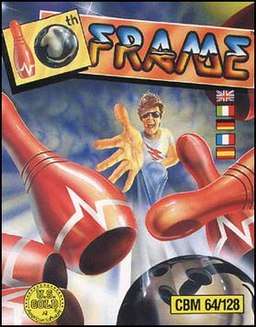10th Frame
10th Frame is a ten-pin bowling simulation game published by Access Software in 1986. Up to eight players can take part in open bowling or a tournament. It was released for the Amstrad CPC, Atari ST, Commodore 64, IBM PC compatibles, MSX, and ZX Spectrum.
| 10th Frame | |
|---|---|
 | |
| Developer(s) | Access Software |
| Publisher(s) | U.S. Gold |
| Platform(s) | Amstrad CPC, Atari ST, Commodore 64, IBM PC, MSX, ZX Spectrum |
| Release |
|
| Genre(s) | Sports |
| Mode(s) | Single-player |
Gameplay
The lane is viewed from behind the bowler, with the pins towards the top of the screen in a 3D perspective.[1]
The scorecard for the current player is displayed above the lane. The player can move left or right on the lane before starting the run-up by holding fire. A target cursor can be moved by pushing up and then moving it left or right (pressing down returned control to moving the onscreen player's position).[1]
Once the fire button is held, a power meter similar to Leader Board's is used. The speed of the shot is determined by how long the button is held down. A small zone at the top determines if the player makes an error, exaggerating any spin.[1]
When the meter starts to descend on the right, it is stopped in the hook zone to determine how much hook/spin is applied—from straight at the top of the zone to full hook at the bottom. Play is completed after the usual ten frames and any bonus balls.[1]
Players can print out a scorecard at the end of a match.
There is a choice of three difficulty levels: Kids (in which the ball always goes straight), Amateur, and Professional.
Reception
| Reception | ||||||||||
|---|---|---|---|---|---|---|---|---|---|---|
| ||||||||||
Computer and Video Games reviewed the Commodore 64 version in issue 65 and called it a Game of the Month with a 9/10 score. Zzap!64 awarded the game 85% in issue 22, calling it "another slick and extremely well programmed Access sport simulation".[1] Your Sinclair gave the ZX Spectrum conversion 7 out of 10, stating that "10th Frame requires a lot of skill and is a pretty good simulation".[3]
References
- "Test: Tenth Frame". ZZap! 64. Issue 22. February 1987. p. 130. Retrieved February 21, 2016.
- "C+VG Reviews: 10th Frame". Computer and Video Games Magazine. Issue 65. March 1987. pp. 14–15. Retrieved February 21, 2016.
- Robson, Rick (April 1987). "10th Frame". Your Sinclair. Issue 16. Archived from the original on 2016-03-01. Retrieved February 21, 2016.
External links
- 10th Frame at Atari Mania
- 10th Frame at SpectrumComputing.co.uk
- 10th Frame at Lemon 64